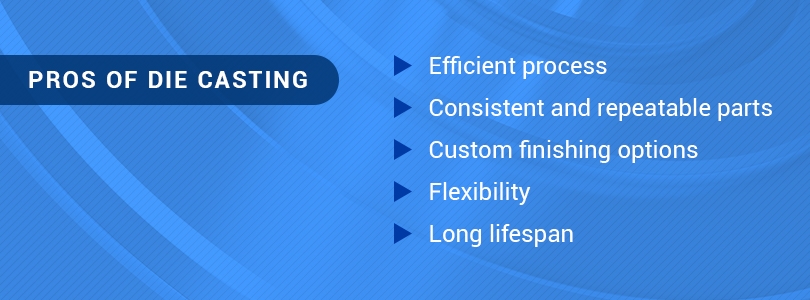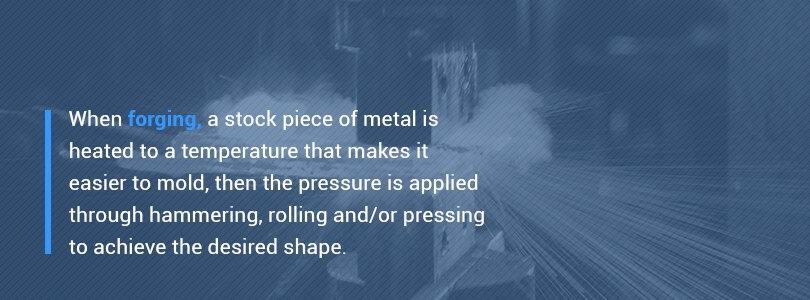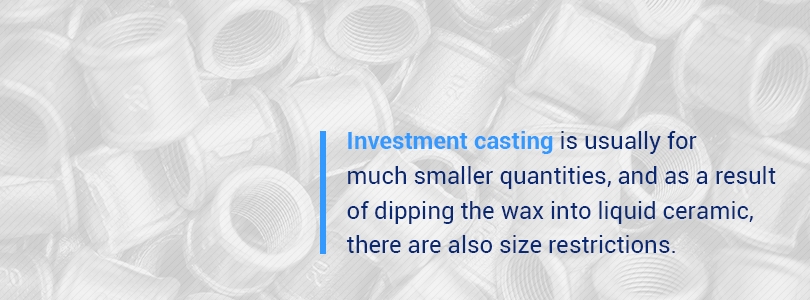
Jump to:
- Pros of Die Casting
- Die Casting vs. Other Casting Processes
- Die Casting vs. Sand Casting
- Die Casting vs. Plastic Molding
- Die Casting vs. Forging
- Die Casting vs. Stamping
- Die Casting vs. Powdered Metal
- Die Casting vs. Metal Extrusion
- Die Casting vs. Investment Casting
- Get Help from Premier Engineered Products
Jump to:
- Pros of Die Casting
- Die Casting vs. Other Casting Processes
- Die Casting vs. Sand Casting
- Die Casting vs. Plastic Molding
- Die Casting vs. Forging
- Die Casting vs. Stamping
- Die Casting vs. Powdered Metal
- Die Casting vs. Metal Extrusion
- Die Casting vs. Investment Casting
- Get Help from Premier Engineered Products
In the simplest terms, die casting is a process for creating metal parts by forcing molten metal under high pressure into steel molds, known as dies. The dies are made from tool steel and contain the pattern for the metal parts.
After the molten metal is pushed into the steel molds, it’s left to cool and harden. Then, the metal is removed in what’s known as a “casting gate.” The casting is the name for the metal parts that have been created and removed in one piece out of the mold. The individual metal parts are then trimmed from the casting gate, and additional operations and finishing are done as needed to create your finished product.
Die cast parts can be simple or complex — regardless of which you need, all of them come with a variety of finish options.
This process of creating parts is one of many options, so what is it that makes die casting stand out? We’ve gathered an overview of some of the general pros of die casting, followed by individual comparisons between die casting and other casting processes so you can see the advantages of die casting.
Pros of Die Casting
Die casting can give you the opportunity to create strong, custom, complex parts by the thousands — or millions — through an upfront investment that’s followed by an efficient process. Here are a few of the overall pros of die casting:
- Efficient process — Once you’ve created the die for your part, it is efficient to reproduce thousands, hundreds of thousands or even millions of individual parts with little machining or additional
- Consistent and repeatable parts — Mass production is a perk, but so is the consistency that comes with it. Because of the precision in die casting, you’re sure to get consistent, repeatable results, which is important when you’re manufacturing specific metal parts.
- Custom finishing options — Whether you’re searching for a smooth or textured finish, die cast parts can be designed to have a specific appearance.
- Flexibility — In addition to the finishing options, there are also a variety of customization options — the thickness of the part, for example, as well as the overall complexity. Die cast parts can be simple or complex — the amount of detail is flexible, making die casting a solution for creating a variety of parts.
- Long lifespan — Die cast parts are not welded or joined together, but rather made from a single mold. This makes them stronger than many other parts — they’re known for being durable. Part of the reason they’re durable is that they’re heat-resistant and dimensionally stable. These qualities and characteristics make it easy to see why they are recognized for lasting longer. We’ll give more information about how their service life compares to other casting processes in the section below.
When you review these overall benefits, it’s easy to see why die casting has become so popular. However, that doesn’t mean it’s right for every job. To help you determine what process is best for you, you need to have some insight into how die casting compares to other casting processes.

Die Casting vs. Other Casting Processes
While the overall general pros of die casting don’t change, they can be elaborated upon when you’re comparing die casting to other casting processes. We’ve addressed some common themes, like production rate, quality and speed, in each of the comparisons below to give you a better idea of how die casting compares to other processes you may be considering. You’ll also find some insight into what type of parts each of these processes is best for, and how that compares to the parts you can create with die casting.
Die Casting vs. Sand Casting
Die casting and sand casting are similar processes, with one major difference — instead of using a steel mold, sand casting uses a mold made out of sand, which involves a few extra steps. A full-size model of the part is created to shape the sand mold. The model makes an impression in the sand mold, which is later used to create the metal parts. An additional sand core may also be used to shape the interior of the part, including any holes or passages that may be needed. While the overall process may be similar, this difference in the mold material results in a few differences between the parts created by each of these processes.
The production rate for sand casting is lower than that of die casting. This process is slower, and therefore, when it comes to mass production of parts, die casting is often preferred, unless you don’t need very many parts. Since sand molds are used, parts created using sand casting will not have the smooth surfaces you can get with die casting. Another factor to take into consideration is that die cast parts can have thinner walls and closer dimensional limits than sand-cast parts, which are primarily thicker than die cast parts.
Die Casting vs. Plastic Molding
The difference between die casting and plastic molding comes in the resulted parts — die cast parts are made of metal, compared to the plastic parts that result from this type of molding. While the speed of the processes is very similar — the liquid plastics are injected into molds, just like the liquid metal of die casting — the resulting parts are different, due to their material composition.
Die cast parts have a much higher tolerance for extreme temperatures and better electrical properties than the plastic molding parts. They also have closer tolerances and are known for being more durable and stable when compared to plastic parts. Another factor to consider is the holes that are needed to assemble the piece to other parts. For example, die cast parts can have a hole cast or drilled directly into them, which can serve as an instant thread for screws. With plastic parts, a metal insert would need to be added to accommodate a thread for a screw, which adds a step, and ultimately, a cost.
Die Casting vs. Forging
The processes of forging and die casting are very different. Die casting focuses on using a mold and liquid metal to create a part, while forging uses a combination of heat and pressure. A stock piece of metal is heated to a temperature that makes it easier to mold, then the pressure is applied through hammering, rolling and/or pressing to achieve the desired shape. Often, this process also involves a mold, but the combination of heat and pressure is used to force the metal into the mold, rather than using a melted version of the metal.
The resulting parts of both processes are metal, so while the temperature tolerance and electrical conduction are the same, the differences in the types of pieces are fairly significant. Forging does not enable you to achieve the level of complexity and detail you can with die casting — therefore, die cast parts have closer tolerances and more complex shapes.
Metal parts made from die casting also can have thin walls and cast coring holes, two characteristics that aren’t possible with parts created through forging. The use of melted metal makes it easier to add alloys through the process of die casting. You’ll find the finishing costs for die casting are lower, too.

Die Casting vs. Stamping
The process of stamping uses a die, but in a different way than die casting. In stamping, the mold is used along with force to cut a piece of sheet metal into the necessary shape. Stamping can produce parts with thin walls, due to the use of sheet metal — however, that means it’s impossible to create metal parts that need to have thicker, more substantial walls through stamping. In addition to thickness, if you’re looking to recreate a complicated part, stamping would likely involve additional steps to create the part you need, ultimately driving up your cost.
Die cast parts also tend to be more affordable as a result of only needing to purchasing the metal that is a part of the metal piece you’re creating. With stamping, you’re purchasing sheet metal, and whatever is left over after stamping your metal parts is discarded — the amount of waste that comes from the process of stamping is greater than that of die casting. Since both die cast parts and stamped parts are metal, they have the same tolerance for extreme temperature and ability to conduct electricity.
Die Casting vs. Powdered Metal
Metal parts can also be made using powdered metal instead of liquid metal. That’s the primary difference between die casting and powdered metal. When you use powered metal, pressure is used to apply it to the mold, creating what’s known as a compact. Then, heat is applied to the compact to fuse the particles together, resulting in a metal part.
Regardless of whether you use liquid or powdered metal, several factors remain the same — both are alloy-friendly, convenient to produce in large quantities and ideal for creating consistent metal parts with precision. The difference between the metal parts formed from liquid metal and powdered metal comes in size and weight. Parts made with powdered metal are thicker and heavier than those made of liquid metal. Molds used in the powdered metal process also tend to be more expensive, making die casting a more affordable option to creating complex metal parts in large quantities.
Die Casting vs. Metal Extrusion
In metal extrusion, a hydraulic or mechanical press forces a piece of metal through a die, creating an extruded product. Perhaps the simplest illustration of this is creating a thin pipe from a thicker piece of metal. Force would be used to press a piece of metal with a larger diameter through a die with the diameter of your desired part, resulting in a smaller version.
While this process is very effective at creating a specific shape, it ends with that. Unless you’re looking for long straight metal parts like L-shapes, T-shapes, tubes and rectangular shapes, metal extrusion likely isn’t for you. The type of material that can be used in the process of metal extrusion is also limited. High-carbon steels, titanium and alloys can be difficult to extrude, so if you need a part made from one of these materials, metal extrusion probably isn’t for you.
Die casting, on the other hand, gives you the opportunity to develop metal parts using the toughest metals and most complex demands. With die casting, customization is possible — and better yet, can be replicated consistently to recreate thousands and millions of new metal parts.
Die Casting vs. Investment Casting
Investment casting is also known as precision casting or lost wax casting. The difference between investment casting and die casting is in the creation of the mold. In investment casting, a wax pattern of the part is initially created and then dipped into liquid ceramic repeatedly until the ceramic cools and hardens around the wax, taking the shape of the part. Then, the mold is heated to melt the wax, leaving an empty mold made of ceramic, which is then used to create metal parts by gravity pouring the metal into the ceramic molds, much like the process of die casting although the die cast metal is injected into the mold with high pressure, not gravity.
Part prices for investment casting are higher, due to the higher amount of manual labor and precision involved in making the molds and parts. While there are times when this type of casting makes sense, it’s usually for much smaller quantities and parts with undercuts that cannot be die cast, when there may be some flexibility to spend more money. There are also size restrictions that come with investment casting as a result of dipping the wax into the liquid ceramic — it must fit on the tool used to dip the wax into the liquid ceramic, called a sprue.

Premier Engineered Products for Your Die Casting Needs
The decision regarding die casting vs. other casting processes ultimately depends on the number of parts you need and the characteristics you’re looking for in a new metal part. Overall, die casting gives you the opportunity to mass-produce consistent metal parts with a variety of options, from the complexity to the finish. While the information regarding each of the processes is valuable insight, you may still have remaining questions as you evaluate what process is going to make the most sense for you and your business. Whether you are looking for more insight, or are interested in taking advantage of the pros of die casting, we can help.
At Premier Engineered Products, we’ve been providing die casting, CNC machining and metal finishing services to our customers for more than 70 years. Our family-owned, American-based business has partnered with several manufacturing companies to create high-quality, custom metal parts through our die casting services. We have the skill, expertise and experience to create the parts you need.
Regardless of whether you’ve decided to take advantage of die casting services, or want to learn more about how our die casting services can benefit you, contact us today.


